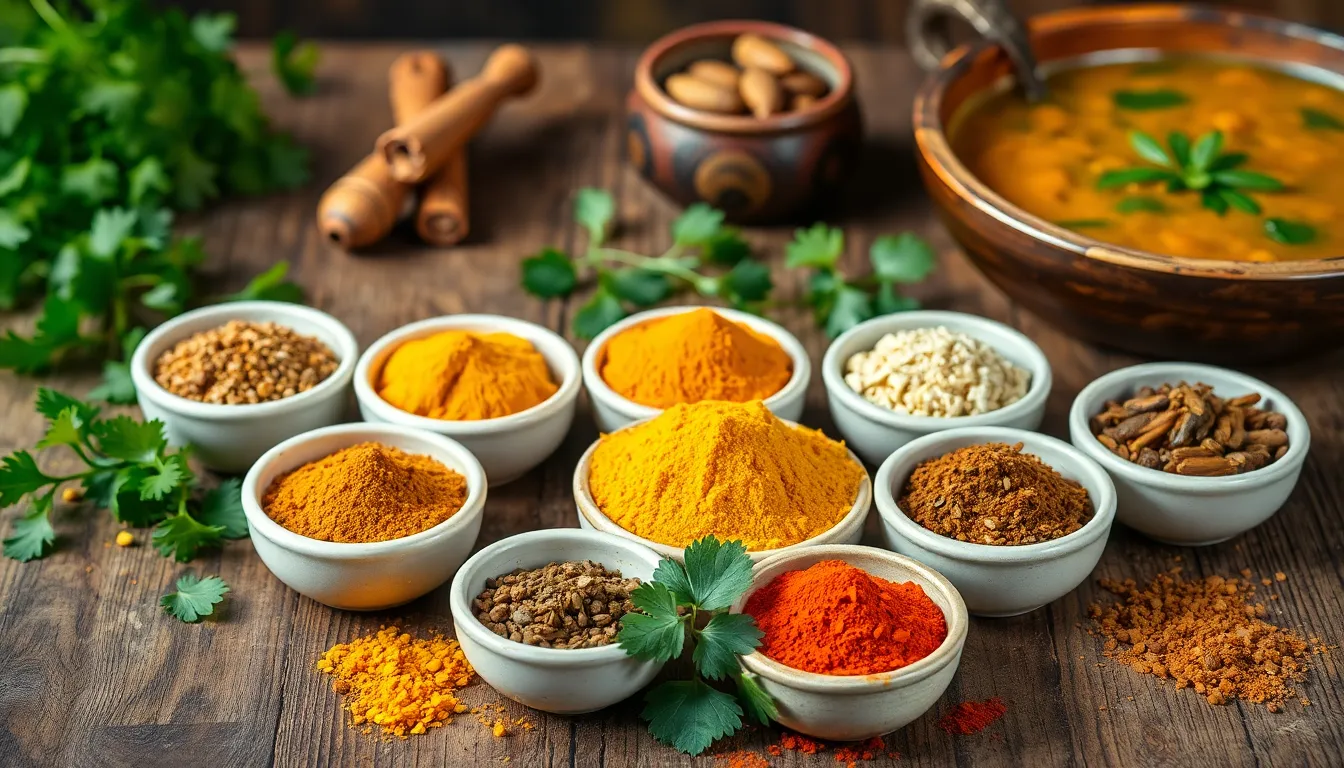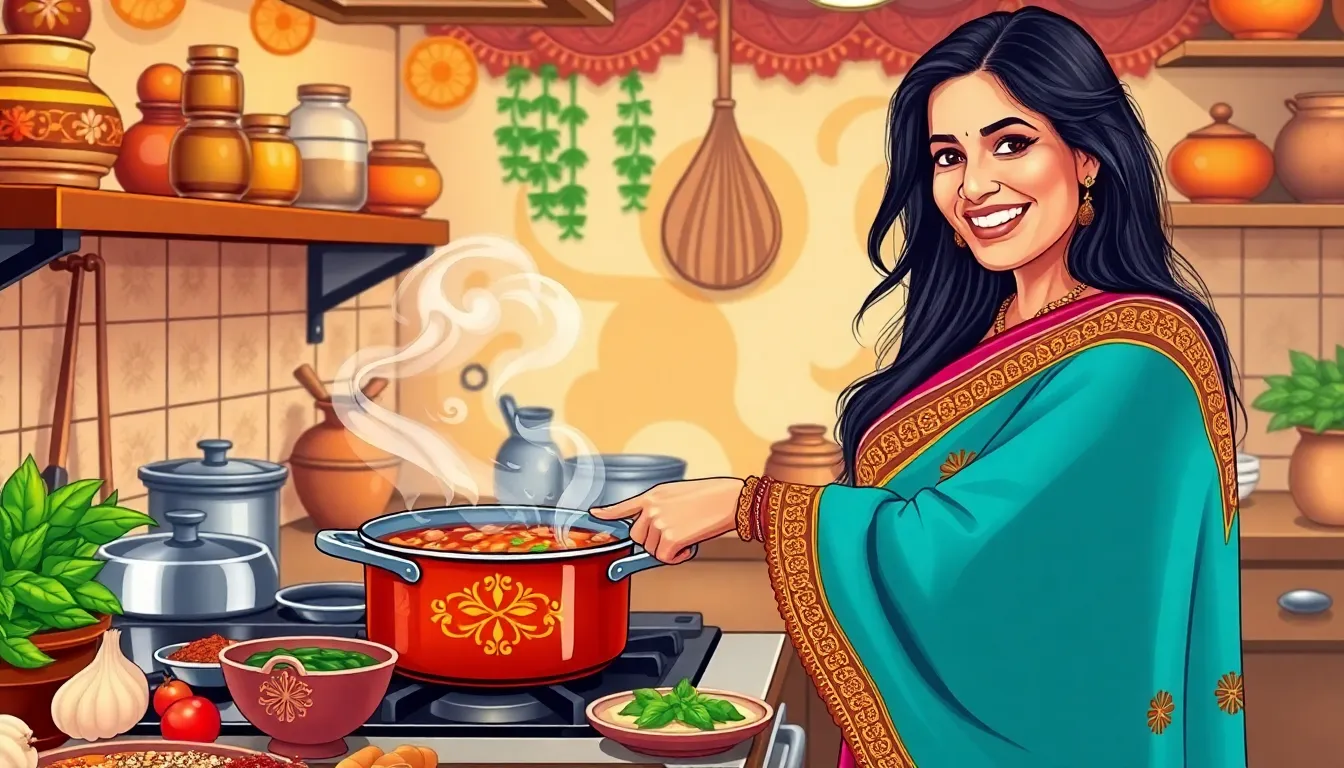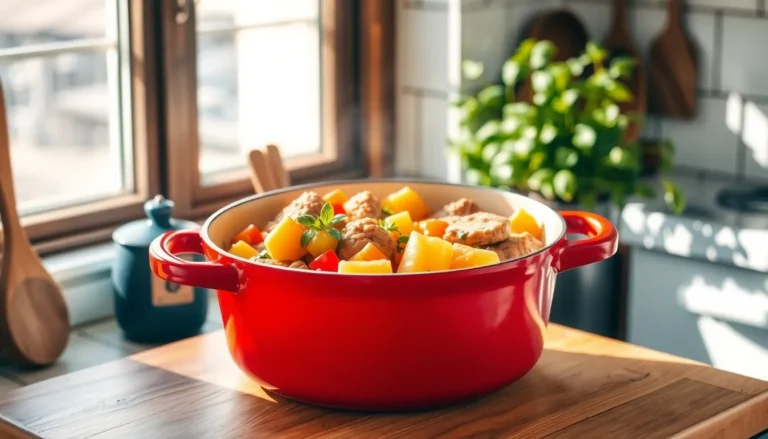Indian cooking is a vibrant tapestry of flavors, aromas, and techniques that have evolved over thousands of years. From the sizzling sounds of tempering spices to the delicate art of kneading dough for perfect naan, each method tells a story steeped in tradition. It’s not just about throwing ingredients together; it’s a culinary dance that transforms ordinary meals into extraordinary feasts.
Table of Contents
ToggleOverview of Indian Cooking Techniques
Indian cooking boasts a variety of techniques that enhance flavor and texture. Tempering spices, known as “tadka,” involves heating oil or ghee and adding spices, releasing their essential oils. This technique adds complexity and depth to dishes like dal and curry.
Another crucial method is marination. Marinated proteins absorb spices, yogurt, or citrus to create tender, flavorful meats before cooking. Tandoori cooking exemplifies this, where marinated items are traditionally cooked in a clay oven at high temperatures, resulting in unique smoky flavors.
Slow cooking, often used in dishes like biryani, allows flavors to meld over time. Rice absorbs rich broths while proteins become tender. Steaming, another technique, preserves nutrients and creates light, airy dishes like idli, a popular South Indian breakfast item.
Furthermore, frying plays a prominent role in Indian cuisine. Deep frying gives texture to snacks such as pakoras and samosas, often served with spicy chutneys. In contrast, sautéing offers a quicker method to cook vegetables and meats, locking in flavors while maintaining a crisp bite.
Grilling also features prominently, particularly in kebabs. These dishes often include marinated meat or vegetables skewered and cooked over open flames, enhancing the savory profile. Lastly, baking, utilized for roti and naan, demonstrates the versatility of Indian cooking techniques while producing various bread types integral to meals.
Each of these methods showcases the meticulous art and tradition of Indian cooking, transforming simple ingredients into flavorful dishes.
Essential Ingredients in Indian Cuisine

Indian cuisine relies heavily on a variety of essential ingredients that enhance flavors and textures.
Spices and Seasonings
Spices form the backbone of Indian cooking. Common spices include cumin, coriander, turmeric, and garam masala. Each spice adds unique flavor profiles. Cumin seeds, when toasted, release an earthy aroma that complements curries. Garlic and ginger paste serves as a robust base for many dishes. Additionally, chili powder adds heat, balancing flavors in sauces and marinades. Fresh herbs such as cilantro and mint brighten dishes. Their vibrant colors and flavors uplift the presentation and taste. Understanding these spices is crucial for mastering Indian cuisine.
Grains and Legumes
Grains and legumes are staple components in Indian meals. Rice and various types of flatbreads, like roti and naan, serve as primary accompaniments. Basmati rice, known for its long, aromatic grains, is often paired with rich curries. Legumes, such as lentils and chickpeas, provide protein and fiber. Dal, a lentil dish, is a comforting staple in many households. They not only contribute nutrients but also create hearty meals. Incorporating these grains and legumes creates balance in every Indian meal. Understanding their different varieties aids in elevating traditional dishes.
Common Indian Cooking Methods
Indian cooking employs a variety of techniques that elevate flavors and textures, creating unique culinary experiences. Each method highlights the creativity and tradition within this rich cuisine.
Sautéing and Stir-frying
Sautéing and stir-frying involve cooking ingredients quickly in oil over high heat. Commonly, these techniques are used for vegetables, enhancing their crunchiness and flavor. Shedding moisture quickly contributes to the vibrant colors and textures of dishes. Indian chefs often add spices during this process, allowing the spices to release essential oils. Recipes for dishes such as bhindi masala or vegetable stir-fry benefit significantly from this method, ensuring each ingredient retains its identity while harmonizing with spices.
Steaming
Steaming serves as a healthy cooking method that preserves nutrients and flavors. Dishes like idli and dhokla rely on this technique, resulting in a light, fluffy texture. When steaming, the ingredients sit above boiling water, absorbing the steam’s heat while avoiding direct contact with water. Various Indian meals utilize this method, especially for breakfast or snack options. Steamed vegetables also emerge tender and flavorful, maintaining their natural color and health benefits.
Slow Cooking
Slow cooking allows flavors to develop gradually over time. This method benefits dishes like biryani or dal, where spices meld beautifully with proteins and grains. Ingredients simmer for extended periods, intensifying their flavors. Patience becomes key, as the gentle heat breaks down tougher cuts of meat, making them tender and succulent. Slow cooking works wonders for stews and curries too, offering a comforting, rich dining experience favored in many Indian households.
Baking and Roasting
Baking and roasting play significant roles in Indian cuisine, particularly for breads and meats. Naan and roti represent essential staples, often cooked in a tandoor, giving them a smoky flavor. Roasting spices before grinding enhances their aroma and depth, contributing to the overall flavor profile. Casseroles, such as paneer tikka, also benefit from roasting, bringing out the natural sweetness of the ingredients. These methods showcase the versatility and adaptability of Indian cooking, revealing that simple procedures yield remarkable results.
Regional Variations in Indian Cooking Techniques
Indian cooking showcases a myriad of techniques, each reflecting the region’s unique culture and resources.
North Indian Techniques
North Indian culinary practices often highlight tandoori cooking. Tandoors, clay ovens, impart a distinct smoky flavor to meats and breads. Northern cuisine also emphasizes slow cooking, especially for dishes like butter chicken and biryani, allowing spices to meld harmoniously. Incorporating cream and yogurt is common for rich gravies, enhancing texture and flavor. Stir-frying vegetables with spices like cumin and coriander adds depth, creating colorful and aromatic dishes.
South Indian Techniques
In South India, techniques like tempering with mustard seeds and curry leaves are essential. This method, known as “tadka,” infuses dishes with robust flavors right from the start. Steaming is prevalent in dishes such as idli and puttu, preserving nutrients and providing a light texture. Coconut, an important ingredient, features in many preparations, adding richness. Sautéing vegetables with turmeric and lentils results in hearty curries, showcasing vibrant flavors and colors.
East Indian Techniques
Eastern India is known for its use of mustard oil and subtle spices. Fish, especially, undergoes various preparations like steaming and frying, creating a delicate balance of flavors. Chutneys made from fresh herbs and fruits enhance meals with freshness. Slow cooking methods, like simmering dal with spices, deepen flavors significantly. Additionally, the inclusion of poppy seeds and coconut enriches the regional cuisine, giving it unique character.
West Indian Techniques
West Indian cooking is characterized by bold, vibrant flavors. This region frequently employs frying techniques for snacks such as bhaji and pakora. Additionally, the use of spices like asafoetida and curry powder is prominent in many dishes. Dishes often require slow cooking, which allows spices to develop a complex flavor profile. In coastal areas, seafood is marinated in spice blends before grilling or frying, showcasing the diverse culinary techniques influenced by geography.
Exploring Indian cooking techniques reveals a vibrant tapestry of flavors and traditions. Each method reflects a deep connection to culture and history, showcasing the artistry involved in transforming simple ingredients into delightful dishes. From the aromatic allure of tadka to the slow melding of flavors in biryani, these techniques highlight the thoughtful approach to cooking that defines Indian cuisine.
Understanding the significance of spices and regional variations enriches one’s culinary journey. As home cooks embrace these methods, they not only create authentic meals but also celebrate the rich heritage of Indian cooking. This culinary exploration invites everyone to experiment and appreciate the depth of flavors that Indian cuisine offers.







